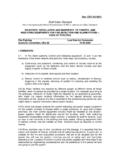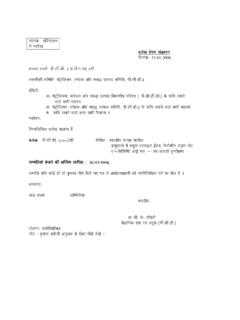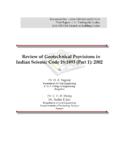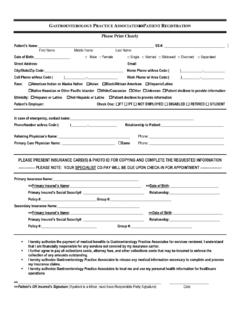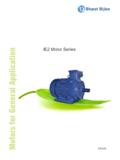Transcription of CODE OF PRACTICE FOR PREPARATION AND USE OF …
1 Indian Standard IS :2260-1981 ( Reaffirmed 1990 ) code OF PRACTICE FOR PREPARATION AND USE OF MASONRY MORTARS ( First Revision ) Third Reprint FEBRUARY 1993 UDC 691-53 : 694 KIl-3 BUREAU OF indian standards MANAK BHAVAN, 9 BAHADUR SHAH ZAFAR MARG NEW DELHI 110002 Gr 7 Jub 1981 IS : 2250 - 1981 Indian Standard code OF PRACTICE FOR PREPARATION AND USE OF MASONRY MORTARS ( First Revision ) Building Construction practices Sectional Committee, BDC 13 Chairman MALII< C-4/38, Safdarjung Development Area, Npw Delhi Members Reprcscntittg S~nr SURAJ S. J. BABADUR Housing & Urban Development Corporation Limited, New Delhi SHRI A. N. BAJAJ SRRI D. R. BATLIVALA Forest Research Institute & Colleges, Dehra Dun SHRI J.
2 R. BHALLA Bhabha Atomic Research Centre, Bombay Indian Institute of Architects, New Delhi SHRI M. C. BHARQAVA Public Works Department, Government of Uttar SERI R. K. MATHUR ( Alternate ) Pradesh, Lucknow CH;;~E~;INEER ( BLD~S ), PWD, Public Works Department, Government of Tamil Nadu SUPERINTENDING ENGINEER, ( SPECIAL BUILDING CIRCLE ), PWD, MADURA~ ( Alternate ) CEIEF ENQINEER-CUM-ADDITIONAL Public Works Department, Government of SECRETARY TO TEE GOVERN- Rajasthan MENT (B&R) EXECUTIVE ENGINEER ( DESIQN & SPECIFICATION ) ( Alternate ) CHIEF ENGINEER ( NDZ ) SUPERINTENDINGI SURVEYOR Central Public Works Department, New Delhi OF WORKS ( NDZ ) ( Alternate ) D 1 R E c T o R ( ARCHITECTURE ), RDSO, LUCKNOW Railway Board ( Ministry of Railways ) JOINT DIRECTOR ( ARCHITEC- TURE ), RDSO, LU~ENOW ( Aftemalc ) ( Continued on page 2 )
3 0 Copyright 1981 BUREAU OF indian standards This Bublication is protected under the Indian Copyright Act (XIV of 1957) and reproduction in whole or in part by any means except with written permission of the publisher shall be deemed to be an infringement of copyright under the said Act. IS:22!.50-'1981 ( Conrinucdfrom page 1 ) Members Representing SHXI H. S. DUQAL Builders Association of India, New Delhi BRIG HARISH CHANDRA ( -4ltcrnote) San1 B. S. GREWAL Public Works Departmenr, Government of &KRI R. L. KUMAR Punjab, Chandigarh Institution of Surveyors, New Delhi SRRI K. S. KHARB (Alternate ) SHRI M. 2. KURIEN Tata Consulting Engineers, Bombay SRI G. K. MAJUMDAR Hindustan Prefab Limited, New Delhi SHRI H.
4 S. PASRICHA ( Alternate ) SHRI R. C. MANGAL Centr$orziding Research Institute ( CSIR ), SRRI J. P. JAIBINQH ( Altern& ) SRRI R. K. PANDARE Life Insurance Corporation of India, Bombay DEPUTY CIXIEF ENQINEER SHRI RTR@o& ) . SHRI T: K. SARAN Public Works & Housing Department, Bombay Bureau of Public Enterprises ( Ministry of SHRI S. S. KAIMAL ( Alfcrnatc ) Finance ), New Delhi SHRI R. D. SINC?H Engineer-in-Chief s Branch, Army Headquarters, New Delhi SHRI M. G. VIR~ANI ( Alternutc ) SHRI S. R. SIVASWAMY Gammon India Ltd, Bombay SH~I H. D. MATANQE ( Altcrnafc ) SERI K. S. SRINIVASAN DEPUTY DZ~E~TOR ( Altern& ) National Buildings Organization, New Delhi SHRI SUSHIL KUMAR National Buildings Construction Corporation Ltd, New Delhi SRRI B.
5 T. UNWALLA Concrete Association of India, Bombay SHXI Y. K. MERTA ( Alternate) SHRI B. T. UNWALLA Institution of Engineers ( India), Calcutta SERI JIVAN DATT ( Ailcrnate ) Soar G. RYAN, Director ( Civ Engg ) Director General&$ ( Ex-ojicio Member ) Secretary SHRI S. SFX GIJPTA Assistant Director ( Civ Engg ), ~1s Masonry Construction Subcommittee, BDC 13 : 7 Convcncr DR R. K. GHOSH Centgraload Research Institute ( CSIR ), New Members Cnrss EN~INER~ National Buildings Construction Corporation Ltd, New Delhi SIIRI DALJIV SINGH (Altrrmtc) ( Continued on page 31) 2 IS:2250-1981 Indian Standard code OF PRACTICE FOR PREPARATION AND USE OF MASONRY MORTARS ( First Revision ) 0. FOREWORD This Indian Standard (First Revision ) was adopted by the indian standards Institution on 27 February 1981, after the draft finalized by the Building Construction practices Sectional Committee had been approved by the Civil Engineering Division Council.
6 Choice of masonry mortar is governed by several considerations, such as type of masonry, situation of use, degree of exposure to weather, strength re*quirements, besides special considerations like fire resistance, insulation, rate of setting and hardening, etc. The ingredients for mortar have also a wide variety. Cementitious ingredients may be cement or lime or combinations of these and with or without addition of pozzolanas, plasticizers, etc. The aggregates may be sand, burnt-clay aggregate or cinder. As many of these ingredients have a wide variation in charac- teristics, the proportions in which they are to be mixed depend largely on practical experience with local materials. However, with the development of standard specifications to govern the quality of cement, lime, sand and other pozzolanic materials, it is possible to apply some of the basic principles for selection and use of masonry mortars, which have accrued as a result of research work in this field in the country and abroad.
7 This standard is intended to provide such guidance regarding properties and use of masonry mortars. This standard, published in 1965, was intended to bring out a long felt uniformity in the variety of practices being followed by various organizations in the country in the PREPARATION of cement mortars, cement lime mortars and their use is masonry works. A separate standard, namely IS : 1625, was published in 1962 and revised in 197 1 covering information regarding properties and PREPARATION of lime mortars and their use in masonrv works. The Sectional Committee resoonsible for the the PREPARATION of ihis standard, while taking- up this revision, felt that requirements for both cement mortars and lime mortars should be 3 IS : 2250 - 1981 brought together in one standard.
8 Thus, this revision is prepared incorporating the provision of IS: 1625-1971 and to incorporate improvements found necessary in the light of the usage of the standard, and the suggestions made by various organizations implementing it. IS : 1625-1971 will be withdrawn with the printing of this revision. In this revision, number of changes have been incorporated. The most significant being the gradation of masonry mortars only in terms of. their minimum compressive strength ( at the age of 28 days), since proportioning of mortars by loose volume would not allow adjustment to take care of variations in the quality of the ingredients (see Table 1). However, volumetric proportioning ( by loose volume ) being the only PRACTICE being followed in the country, mortars in terms of different nominal mix proportions and which would give the range of above compressive strengths ( at the age of 28 days ) have also been included in this revision as a guidance to the users.
9 The technical committee responsible for the PREPARATION of this revision feels that where facilities for determining the actual mix proportion corresponding to the specified grade are not available, the nominal mixes as specified in this revision may be used. The committee in this respect recognises the existence of additional mixes other than what has been included in this revision, which might provide greater flexibility of choice to the users, But it is f+ that inclusion of all possible combinations might not only burden the code but also might not be needed for the construction of great majority of masonry. The committee also appreciates the necessity o[ reflecting the expected increase in strength of lime based mortars after 28 days, which is otherwise the basis of gradation of masonry mortars, and feels the necessity of including a provision for taking advantage of this expected increased strength.]
10 But in the absence of definite technical data, the concept of substantial growth in strength of lime based mortars after 28 days is being excluded from the present version. Investigations are in progress and the information will be added in the standard as and when available. Further, the method of mixing the ingredients for various types of mortars has been dealt in detail in this revision and the method of determining the compressive strength of mortars has been modified. Only SI units have been used in this revision. For the purpose of deciding whether a particular requirement of this standard is complied with, the final value, observed or calculated, expressing the result of a test or analysis, shall be rounded off in accordance with IS: 2-19607.

